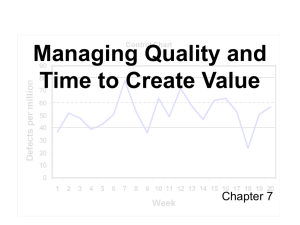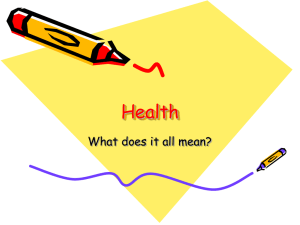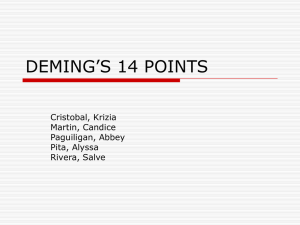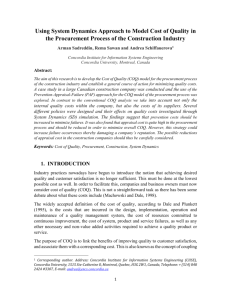Quality and Business Performance
advertisement
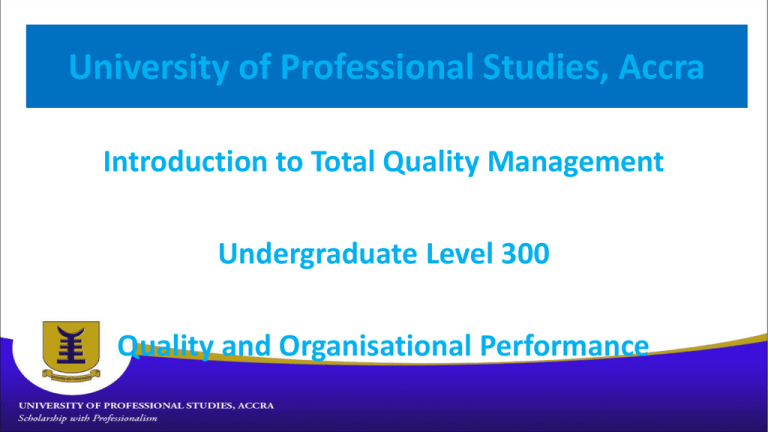
University of Professional Studies, Accra Introduction to Total Quality Management Undergraduate Level 300 Quality and Organisational Performance Learning Outcome By the end of this lecture, students should be able to: Discuss business performance and their indicators Explain the relationship between quality and business performance indicators Compare and contrast the quality triangle to the extended quality triangle Discuss the concept of “cost of quality” Background to the topic Organization in contemporary times are faced with pressures of competition in the business environment. Competition is non-negotiable, external contextual factors that businesses must overcome to survive in the industry. Globalization, technology and current economic recession as well as the increasing knowledge and discerning customers has made this “monstercompetition” gain prominence in all spheres of business arrangements. This has modified the production and service delivery ethos to quality ethics. Businesses believe that Quality is now the strategic differentiation potential for sustained competitive advantage. Business Performance • To this end, various industry practitioners, strategies, researchers and consultants have tried to link quality to business performance. Business performance is explained as the efficiency and effectiveness of business actions to achieve the overall organizational goals (Neely, 1998). As a result the success of a business is equated to its ability to achieve its shared vision, purpose and goals and gained sustained competitive edge. Business Performance Cont’d The Malcolm Baldrige Criteria for Performance Excellence Results category groups performance measures into five sets Customer Financial and Market Human Resource Supplier and Partner Performance Organisational effectiveness Business Performance Indicators • • • • • • • • • • • Profitability Value maximization Growth Reputation-image brand name Customer satisfaction Customer loyalty Market share-customer base (competitive advantage-market superiority) Employee relation (participations, commitment, turnovers) Productivity (sales volume) Expansions Cost of operation What is the relationship between Quality and Business Performance • One of the most common questions posed by executives seeking improvement is : "Will this quality efforts pay off ?" • Edwards W. Deming, the father of Quality Management espoused a theoretical basis to explain the relationship in his “Deming Value Chain”. DEMING’S VALUE CHAIN Source: Adapted from S. T. Foster: Managing for Quality Improve Quality Cost Decrease( Less Reworks, Few Mistakes, Fewer Delay, Better use of machine time and material) Productivity Improves Capture the Market Stay in business Provide jobs and more jobs Empirical findings of the relationship Quality is consider to be the driver for marketing and financial performance strategy of modern businesses. The following studies established a positive( favourable) relationship between Quality and business performance indicators • Cost (Crosby 1984) • Profitability (buzzel and Gale 1987) • Customer satisfaction (bolten and Drew 1991) • Customer retention • Positive word of mouth (Reicheld & Sasser 1990) Relationship cont.d The U.S. General Accounting Office (GAO) performed a study of 30 Malcalm Baldrige award winners and found the effects of quality improvement to include; improved employee relations, lower cost, greater customer satisfaction, and improved market share. Relationship Cont.D Further studies by PIMS Associates Inc. a subsidiary of Strategic Planning institute conduct a study involving 1200 companies on the topic “the impact of product quality on corporate performance” and their findings reveals as model by the next slide: • Determinant of business profitability • Usually results in high market share at the cost of reduced short-run profitability • Positive and significant related to return on investment-3times difference • Commands higher prices as a result of perceived value Quality and indicators Cont’d (PIMS Findings) Improved Quality of Design Improved Quality of Conformance Higher Perceived Value Higher Prices Lower Manufacturing and Service Costs Increased market Share Increased Revenue Higher Profitability Factors affecting Quality and Business Performance • Competitions ( six dimension of competitions –quality triangle and external quality triangle) • Resources (10 Ms) • Technology Competition Quality Triangle William Procter, one of the founders of Procter and Gamble identified three dimensions of competition for a product: • Cost of the product (price) • Availability of the product (level of productivity) and • Quality of the product Quality Product Cost of Product Availability of Product Competition Cont’d Subsequent research by Noori et al, 1996 argued that competition is not solely focused on the product but the organisation as part of the environment is paramount. Therefore an organisation with a bad reputation would find it difficult selling its products or services. They therefore proposed an extension of the triangle with three new dimensions of competition: Flexibility Dependability -Reliability (consistency) and Serviceability The Extended Quality Triangle Dependability Cost of Product ORG Availability of the Product Product Flexibility Serviceability Quality of the Product Resources • • • • • Man Machines Materials Money Methods • • • • • Message (information) Milieu (environment) Management systems Manners (attitude) Minutes/moments (time) Money: Constant pressure for managers to operate within very tight budgets which creates tension between making profit and expenditure on quality and performance improvements (cost-cutting). Cash flows, access to additional funding, existing debt burden, cost of capital. Machines: Facilities and equipment: capabilities, location, age, maintenance and replacement cost Methods: How organisations conceptualise quality and business performance and set about to achieve it. Operations, marketing, HR, supplies Materials: Forms the inputs for the realisation of products and services. Raw materials, existing products and services, potential for new products Management: An act, art or manner of Planning, Leading, Organizing and Controlling .... Message: (information)Inform, request, persuade, build good will, ICT, Advertisements Moments: (timings) Seizing business opportunities at the right time Planning time, product design time, delivery time, response time for complaints Milieu (Environment): Consideration of events that present threats and opportunities . SWOT Competitor’s activities: number and strength of competitors, basis of competition – price, special features, changing consumer needs Markets: Size, location, ease of entry, potential for new markets/growth, demographics Concept of “Cost of Quality” • It’s a term that's widely used – and widely misunderstood • What is Cost of Quality? Cost of Quality (COQ) Cost of Quality refers to total cost incurred by an organization to on the following three key activities: • Investing in the prevention of nonconformance to requirements • Appraising a product for conformance to requirements. • Failing to meet requirements. COQ=Prevention Cost + Appraisal Cost + Failure Cost Types of Quality Cost (The first two costs are incurred in the hope of preventing the second two) Quality Control Costs prevention costs and appraisal costs. Quality Failure Costs (cost consequences of poor quality) External Failure Costs Internal Failure Costs Prevention Costs They are all costs incurred in the process of preventing poor quality from occurring. Usually before producing a product. • Quality planning costs • costs of product and process design • Process capability evaluations • Cost of new product reviews • Cost of Researching to know customer requirements • Employee training in quality measurement education • Quality improvement team meetings • Quality improvement projects Appraisal costs They are incurred in the process of uncovering defects for improving before the product is sold to the customer: • quality inspections • product testing • performing audits • costs of worker time spent measuring quality • cost of equipment used for quality appraisal. • Cost of calibration of testing equipment's Failure cost The costs resulting from products or services not conforming to requirements or customer/user needs. • Failure costs are divided into Internal failure cost External failure cost Internal Failure Cost Failure costs occurring prior to delivery or shipment of the product, or the furnishing of a service, to the customer. They are associated with discovering poor product quality before the product reaches the customer site Examples includes cost associated to • Scrap • Rework • Re-inspection • Re-testing • Material review • costs of discounting defective items for salvage value. • Downgrading External Failure Costs Failure costs occurring after delivery or shipment of the product and during or after furnishing of a service to the customer.They are associated with quality problems that occur at the customer site. These costs can be particularly damaging because customer faith and loyalty can be difficult to regain. Examples of costs associated with this includes: • Processing customer complaints • product returns • warranty claims • recalls • litigation costs resulting from product liability issues. • cost is lost sales and lost customers Summary of Cost Of Quality Quality Control Cost Prevention costs Appraisal costs Costs of preparing and implementing a quality plan. Costs of testing, evaluating, and inspecting quality Quality Failure Cost Internal failure costs External failure costs Costs of scrap, rework, and material losses Costs of failure at customer site, including returns, repairs, and recalls Summary Companies that consider quality important invest heavily in prevention and appraisal costs in order to prevent internal and external failure costs. The earlier defects are found, the less costly they are to correct. For example, detecting and correcting defects during product design and product production is considerably less expensive than when the defects are found at the customer site. Continues: External failure costs tend to be particularly high for service organizations. The reason is that with a service the consumption and production is simultaneous for the organisation and its customer. Hence there are fewer opportunities to correct defects than there are in manufacturing. Examples of external failure in services include an airline that has over- booked flights, long delays in airline service, and lost luggage. Reference • Evans, J.R. & Lindsey, W.M. (2002). The Management and Control of Quality (5th Ed.). South-Western College Publishing: USA. • Evans, J.R. & Lindsey, W.M. (1999). The Management and Control of Quality (4th Ed.). South-Western College Publishing: USA • Alabi, G. B. (2013). Technology in Quality Management, Lecture note. Accra: UPSA • Chuck, W. (2009). Management (5th Ed.). South-Western Cengage Learning: USA • Pegels, C.C. (1995). Total Quality Management, a Survey of its Important Aspects. Boyd & Fraser publishing company: Danvers, Massachusetts THANK YOU
